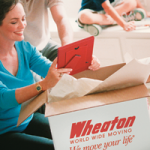The last few years have seen a rise in the number of plant parents across the United States. 1 in 3 Americans under age 40 own at least one household plant, while 66% of all US homeowners have one or more as well. As the name suggests, plant parents are oftentimes very invested in the health and growth of their plants, so when the time comes to relocate, there are many ways to ensure the safety of plant children.
Central Moving and Storage is a reliable moving company based out of Orlando with nearly 40 years of experience to our name. Founded back in 1985, we've completed countless residential relocations successfully, and have helped homeowners move a wide variety of important belongings, including plants. Below are some of our best tips for keeping your plants safe during a move!
Securely Wrap the Base of Your Plant
The first step in successfully transporting your plant during a relocation is to firmly wrap the base of the plant. The objective is to contain all the soil during transportation, so that your plant remains safely potted and your vehicle doesn't get messy during the process!
Using a plastic bag or something similar, enclose the entire base of your plant and tie it off significantly above the soil line, eliminating the chance of soil spilling out. The bag should be wrapped tightly enough to keep the soil in place, but not too tightly as to injure your beloved plant.
Make Sure Your Plant has Sufficient Space
Because most indoor plants have at least some flexibility, it can be tempting to try and force them to fit inside boxes that are probably a bit too small. While this saves room during your move, you run the risk of greatly damaging your plant. Opt instead for a soft-sided bag or something similar, which will give your plant space for its delicate branches and foliage.
If you're transporting your plant in your personal vehicle, you may have to tilt it to one side in order for it to fit. Reduce the amount of pressure on your plant by padding the sides of the trunk, which will keep the leaves and foliage from bearing the majority of your plant's weight.
Make Note of the Weather Outside
Our indoor plants may need sunlight, water and air, but they are used to a controlled indoor environment. If your plants will be outside on moving day for an extended period of time, there are many things plant owners should consider:
- Direct Sunlight: Sunlight through a window is far less intense than direct sunlight, so if your plants will be outside for hours while you relocate, you should cover them to keep them healthy.
- Hot Car Interiors: If your relocation is planned for the summer months, be mindful to not leave your plants inside a hot car for too long, or you'll run the risk of permanently damaging them.
- Winter Conditions: When there are freezing temperatures outside, your indoor plants should not be exposed for longer than a few minutes while being transported to or from a vehicle. Keep them covered to prevent breakage or stunted growth!
Leave it to the Professionals
If you are already hiring the help of a trusted moving and storage company, our final tip is to let the movers handle your household plants. Professional movers should have the equipment and resources needed to move delicate items, and more space than your personal vehicle, making this an ideal option.
Central Moving and Storage provides full-service moving to our valued customers, in which we'll wrap breakable belongings by hand, and customize our crates for uniquely shaped and irreplaceable items, making the handling of household plants a breeze for our household movers.
As agents of Wheaton World Wide, we're part of a strong global network, and can easily relocate your plants and other belongings anywhere in the world, ensuring their safety every step of the way. Call us today for a free estimate on any of our moving and storage services, and hear more about what we can do!
Subscribe to Central Moving & Storage's Blog











Comments